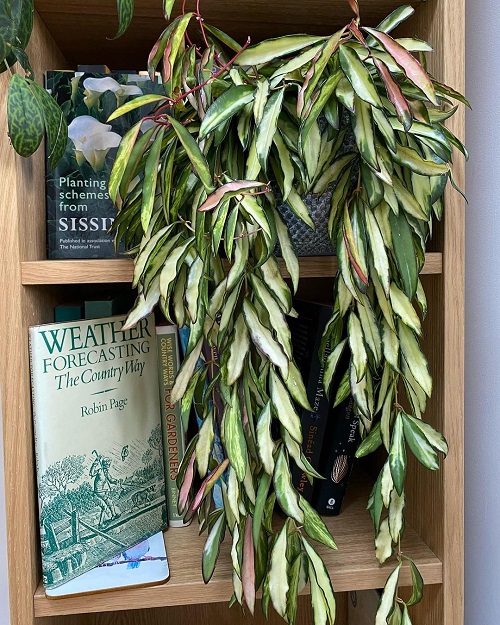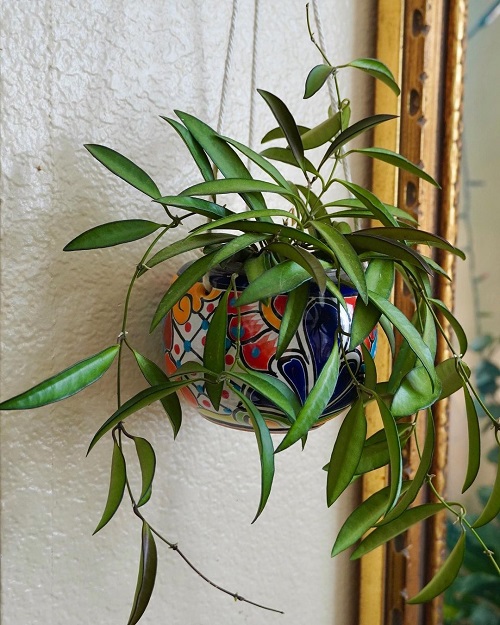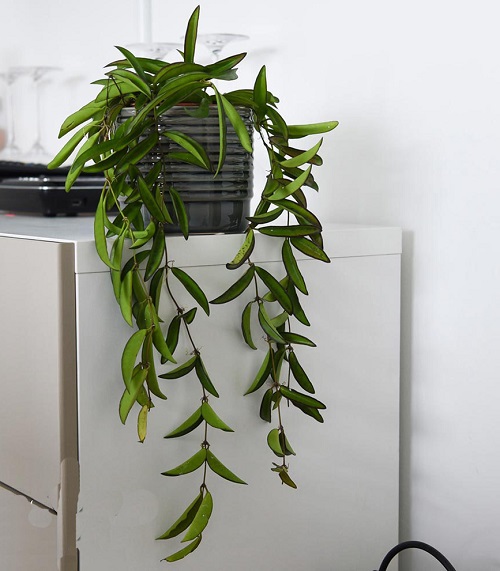Hoya Wayetii is a beautiful trailing specimen that can be a great addition to shelves! Here’s all about growing it easily!

Hoya Wayetii adds charm to any space with its striking variegated leaves and unique star-shaped flowers. Let’s have a look at how to maintain it at the best of its health!
Check out Hoya Pubicalyx Care and Growing Guide here
Hoya Wayetii Information
The Hoya Wayetii is a popular houseplant known for its attractive foliage and stunning blooms. Native to the Philippines, this vine has become a staple in many American households for its minimal care requirements and aesthetic appeal.
Indoor Growth
The trailing vines can extend anywhere from 3 to 6 feet or more, particularly if they are allowed to grow without pruning.
Outdoor Growth
Outdoor vines can become quite extensive, potentially reaching lengths of 6-10 feet, especially if supported on a trellis or similar structure.
Leaves
- Color: The leaves are primarily green but can have red edges when exposed to bright light.
- Shape: Elongated and slightly curved, resembling the shape of a canoe.
- Texture: Waxy and smooth, giving the plant a unique visual appeal.
- Size: Typically, the leaves range from 2 to 4 inches in length.
Flowers
- Color: The flowers are usually pink or red and have a star-shaped form.
- Scent: These blooms often emit a pleasant, sweet fragrance, especially during the evening.
- Blooming Period: Hoya Wayetii generally flowers in late spring to early summer, but this can vary depending on care and environment.
Check Small Leaf Hoya Varieties here
Propagating Hoya Wayetii

Propagation Methods for Hoya Wayetii:
- Stem Cuttings
- Leaf Cuttings
- Layering
- Seed Propagation
Easiest Method – Stem Cuttings:
- Select a healthy stem from the parent plant. The stem should have at least a few nodes (points where leaves are attached) and be around 4-6 inches long.
- Make a clean cut just below a node on the selected stem using a sharp knife or scissors. Ensure that the cutting has a node or two on it.
- Allow the cut end of the stem to air dry for 1 day. This helps to prevent rotting when the cutting is placed in the soil.
- Prepare a well-draining rooting medium, such as a mix of perlite and potting soil. You can also root the cutting in water if you prefer.
- Insert the cut end of the stem into the rooting medium, burying at least one node below the surface. If using water, submerge the node under the water.
- Place the potted cutting in a warm and bright location with indirect light. If using water, ensure the node is submerged and change the water regularly.
- You should notice roots developing from the nodes in a few weeks to a couple of months. Once the roots are several inches long, the cutting is ready for transplanting.
- Gently transplant the rooted cutting into a larger pot with regular potting soil. Keep it in the same light conditions as before.
- Water the newly transplanted cutting and continue to care for it as you would for a mature Hoya Wayetii plant.
Check Hoya Caudata Sumatra Care and Growing Information
Best Pot Size for Hoya Wayetii

Starter Plants
- Pot Size: For young or starter plants, a pot with a diameter of 4 to 6 inches is generally sufficient.
- Consideration: Ensure the pot has good drainage to prevent root rot.
Mature Plants
- Pot Size: For a fully grown Hoya Wayetii, you may need a pot ranging from 8 to 12 inches in diameter.
- Consideration: Again, drainage is essential, and a slightly larger pot will provide space for root growth.
Explore Stunning Types and Species of Hoya
Requirements for Growing Hoya Wayetii
Sunlight
This hoya variety grows well in bright, indirect light. Place it near an east-facing window for optimal sun exposure without direct rays. Avoid intense afternoon sun, which can scorch leaves. If the light is too low, growth may slow.
Regularly rotate the plant to ensure even growth and prevent leaning towards the light source.
Soil
Hoya Wayetii prefers well-draining soil. A mix of potting soil, perlite, and orchid bark in a ratio of 2:1:1 promotes healthy growth.
Ensure the soil pH ranges from 6.0 to 7.0. This blend allows proper water drainage, prevents root rot, and mimics the plant’s natural epiphytic habitat.
Water
Water the plant moderately, allowing the top inch of soil to dry before watering. Inactive growth periods, like winter, require even less water.
Overwatering can lead to root rot, while too little water can stress the plant. Strike a balance to maintain soil moisture without waterlogging.
Temperature and Humidity
Maintain Hoya Wayetii in temperatures between 65 to 90°F (18 to 32°C) during the day and no lower than 50°F (10°C) at night.
It adapts to average household humidity but benefits from slightly higher levels, around 40-60%. Protect it from drafts and sudden temperature changes, as they can stress the plant.
Discover Hoya Plant Ideas to Display Them in Style
Hoya Wayetii Care
Fertilizer
Types of Fertilizer Suitable for Hoya Wayetii
1. Balanced Liquid Fertilizer
- N-P-K Ratio: 20-20-20 or similar balanced ratio
- Benefits: Provides equal amounts of nitrogen, phosphorus, and potassium, essential for overall plant health.
2. Bloom-Boosting Fertilizer
- N-P-K Ratio: 10-30-20 or similar
- Benefits: Higher phosphorus content promotes better blooms, especially during the flowering season.
Recommended Dosage
For Balanced Liquid Fertilizer
- Dosage: Dilute to half the manufacturer’s recommended strength.
- Application: Apply every 3-6 weeks during the growing season (spring and summer).
For Bloom-Boosting Fertilizer
- Dosage: Follow the manufacturer’s guidelines but consider diluting to 75% strength.
- Application: Apply once or twice during the flowering season.
Frequency
- Growing Season: Fertilize every 4-6 weeks during spring and summer.
- Dormant Season: Reduce fertilization to once every 8-12 weeks in fall and winter. If you live in a warm/hot climate – you can skip this.
Pruning
Prune Hoya Wayetii during the active growing season, which is typically in spring or early summer. This timing allows the plant to recover and put out new growth more readily.
Remove any dead, yellowing, or leggy stems and trim back excessive growth to maintain a neat and compact appearance.
Pests and Diseases
Hoya Wayetii can be susceptible to a few pests and diseases. Common pests include mealybugs, aphids, and spider mites, which can be treated with insecticidal soap or neem oil. Watch out for root rot caused by overwatering or poorly-draining soil.
Ensure good airflow and avoid wetting the leaves to prevent fungal issues. Regularly inspect the plant to catch and address any problems early.
Check out Hoya Joy Growing and Care Information
Common Hoya Wayetii Problems and Solutions: A Troubleshooting Guide
1. Yellowing Leaves
Problem:
Yellowing leaves can be caused by overwatering, poor drainage, or insufficient sunlight.
Solution:
- Adjust watering: Allow the top inch of soil to dry before watering again. Ensure proper drainage to prevent waterlogged soil.
- Check light conditions: Provide bright, indirect light to encourage healthy leaf color.
2. Drooping Leaves
Problem:
Drooping leaves might indicate underwatering or inadequate humidity.
Solution:
- Water appropriately: Keep the soil consistently moist but not soggy. Adjust watering frequency based on the plant’s needs.
- Increase humidity: Place a tray of water near the plant or use a humidifier to raise humidity levels.
3. Lack of Blooms
Problem:
Insufficient blooming could be due to inadequate light, incorrect fertilization, or stress.
Solution:
- Optimal light: Ensure your Hoya Wayetii receives bright, indirect light. A few hours of morning sunlight can also be beneficial.
- Fertilize appropriately: Use a balanced liquid fertilizer at half the recommended strength during the growing season.
- Reduce stress: Avoid frequent movement of the plant and maintain consistent care routines.
4. Root Rot
Problem:
Root rot can occur due to overwatering or poor drainage, leading to wilting and discolored leaves.
Solution:
- Adjust watering: Allow the soil to dry out between waterings. Ensure your pot has proper drainage.
- Repotting: If the plant is severely affected, carefully remove it from the pot, trim away affected roots, and repot in fresh, well-draining soil.
5. Leaves Turning Brown at Edges
Problem:
Brown edges on leaves might indicate low humidity or inconsistent watering.
Solution:
- Increase humidity: Place a humidity tray nearby or mist the plant regularly.
- Water consistently: Avoid letting the soil completely dry out between waterings, but also prevent waterlogging.
Hoya Wayetii – Frequently Asked Questions
Q: Can Hoya Wayetii be grown outdoors?
A: Yes, in suitable climates, Hoya Wayetii can be grown outdoors. It prefers a semi-shaded spot with indirect light and protection from harsh elements.
Q: How can I encourage my Hoya Wayetii to flower?
A: Hoya Wayetii typically flowers when mature. Ensure it receives adequate light, proper care, and consistent conditions to encourage the development of its unique star-shaped blooms.
Q: Why are the leaves of my Hoya Wayetii turning yellow?
A: Yellow leaves can indicate overwatering, poor drainage, or nutrient imbalances. Check the soil moisture, ensure proper drainage, and consider adjusting your watering routine. Using a balanced fertilizer can also help address nutrient deficiencies.



